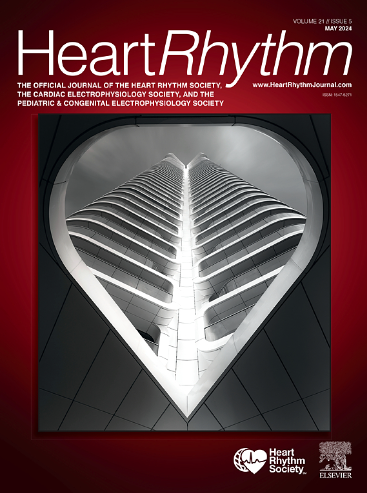接受心律失常综合征基因检测的儿科先证者的临床和遗传变异再分析。
IF 5.7
2区 医学
Q1 CARDIAC & CARDIOVASCULAR SYSTEMS
引用次数: 0
摘要
背景:尽管基因检测的增加,关于遗传性心律失常综合征的诊断率和变异重分类变化的纵向数据是有限的。目的:确定诊断率和变异分类的纵向变化。方法:先证者单中心回顾性研究结果:306个先证者中,首次检测诊断性为23.2%,非诊断性为55.6%(33.7%无变异,21.9% B/LB), VUS为21.2%。当比较时代时,诊断率下降(34.1%至15.3%),VUS增加(9.3%至29.9%),非诊断率保持在55-57%。22.7% (46/203) bbb1变异先证者的变异发生了变化:9.9%的诊断性变异(7/71)降级为VUS或非诊断性变异,60.0%的VUS发生了变化(23.1%升级,36.9%降级)。B/LB变体没有变化。与年龄无关,较高的疾病可能性诊断结果的几率是较低的6倍(OR 6.3, 95% CI 3.2-12.4)。结论:变异重分类导致23%的先证者发生变化,即使在最初被认为是致病的先证者中也有降级和升级的情况。与早期相比,VUS变异增加,而诊断率下降。研究结果支持随着时间的推移对变异进行重新解释和定期重新分类的必要性。本文章由计算机程序翻译,如有差异,请以英文原文为准。
Clinical and genetic variant re-analysis among pediatric probands undergoing genetic testing for arrhythmia syndromes
Background
Despite increases in genetic testing, longitudinal data regarding changes in diagnostic yield and variant reclassification for inherited arrhythmia syndromes are limited.
Objective
Determine longitudinal changes in diagnostic yield and variant classification.
Methods
Single-center retrospective study of probands <18 years undergoing genetic testing for suspected inherited cardiac conditions associated with arrhythmias, 2007 to 2018. Variants were classified as diagnostic (pathogenic/likely pathogenic), non-diagnostic (benign/likely benign [B/LB]), or variants of uncertain significance (VUS). Variant reclassification was performed in October 2023 using VarSome and American College of Medical Genetics criteria. We evaluated results by era (early 2007–2013 vs. later 2014–2018, coinciding with Sanger and next-generation sequencing, respectively) and by likelihood of disease based on clinical evaluation.
Results
Of 306 probands, initial testing was 23.2% diagnostic, 55.6% non-diagnostic (33.7% no variant, 21.9% B/LB), and 21.2% VUS. When comparing eras, diagnostic yield decreased (34.1%–15.3%), VUS increased (9.3%–29.9%), and non-diagnostic remained similar (55% to 57%). Variants for 22.7% (46/203) of probands with ≥1 variant changed: 9.9% of diagnostic variants (7/71) downgraded to VUS or non-diagnostic, and 60.0% of VUS changed (23.1% upgraded, 36.9% downgraded). B/LB variants did not change. Probands with higher disease likelihood had 6-times the odds of diagnostic results compared to lower disease likelihood, regardless of era (odds ratio 6.3, 95% confidence interval 3.2–12.4, P < .0001).
Conclusion
Variant reclassification led to changes in 23% of probands, both downgrading and upgrading status, even among probands initially thought to be pathogenic. When comparing later to earlier eras, VUS variants increased while diagnostic yield decreased. Findings support the need for variant re-interpretation and periodic reclassification over time.
求助全文
通过发布文献求助,成功后即可免费获取论文全文。
去求助
来源期刊

Heart rhythm
医学-心血管系统
CiteScore
10.50
自引率
5.50%
发文量
1465
审稿时长
24 days
期刊介绍:
HeartRhythm, the official Journal of the Heart Rhythm Society and the Cardiac Electrophysiology Society, is a unique journal for fundamental discovery and clinical applicability.
HeartRhythm integrates the entire cardiac electrophysiology (EP) community from basic and clinical academic researchers, private practitioners, engineers, allied professionals, industry, and trainees, all of whom are vital and interdependent members of our EP community.
The Heart Rhythm Society is the international leader in science, education, and advocacy for cardiac arrhythmia professionals and patients, and the primary information resource on heart rhythm disorders. Its mission is to improve the care of patients by promoting research, education, and optimal health care policies and standards.
 求助内容:
求助内容: 应助结果提醒方式:
应助结果提醒方式:


